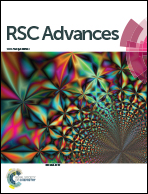Effect of pRi T-DNA genes and elicitation on morphology and phytoecdysteroid biosynthesis in Ajuga bracteosa hairy roots†
Abstract
The medicinal plant Ajuga bracteosa is a rich source of biologically active and metabolism-enhancing phytoecdysteroids. Transgenic hairy roots from A. bracteosa were obtained by infection with Agrobacterium rhizogenes strains A4, LBA-9402 and ARqua1. The 59 selectively established and rolC-positive hairy root lines increased in size up to 6.6-fold (L42) after one month of in vitro culturing and produced a phytoecdysteroid content ranging from 69.3 to 4449 μg g−1 (L3 and A2, respectively). The clones of these transgenic roots were maintained for successive subcultures on hormone-free medium to obtain a stabilized morphology. Hairy roots displayed four different morphologies: typical hairy root (THR) (59%), callus-like (CM) (17%), thick (TK) (14%) and thin (TN) (10%). The growth rate of the transgenic hairy root lines varied according to their morphology, with CM showing the highest rate (3.93-fold per month). However, THR exhibited the highest phytoecdysteroid content (1538.5 μg g−1). Considering the hairy root morphology in relation to the pRi TR-DNA genes, 100% of the hairy root lines harbored the mas1 and ags genes and 90% of CM lines the aux1 gene. Strikingly, the clones with TK morphology were all positive for the TL- and TR-DNA genes. In contrast, 0% of TN clones harbored the aux1 and ags genes, and only 16.7% the mas1 gene. All CM and TK hairy roots were positive for the ags gene, while mas1 was present in all hairy root types except TN. As expected, all the root lines considered in this work were positive for the rol C gene. Eleven hairy root lines displaying a high growth rate and phytoecdysteroid content were elicited with methyl jasmonate (MeJ) and coronatine (Cor). MeJ doubled the phytoecdysteroid content after 14 days of elicitation (8356 μg g−1 in L2) compared with unelicited control hairy roots, and in in vitro-grown untransformed roots the increase was 5.6-fold.



 Please wait while we load your content...
Please wait while we load your content...